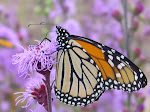
Bringing Nature Home
How Native Plants Sustain Wildlife in Our Gardens
by Douglas W. Tallamy
Tallamy's research as an entomologist make a poignant, positive and pro-active argument for using native plants in our gardens. Many advocates of native plants for gardening and restoration have suspected for many years that non-native, alien ornamental plants do not provide much environmental benefit. Now we have the proof. This books is based on scientific evidence that native plants and native plant communities are essential to support insect populations and the bird populations that feed on them.
He suggest that gardeners can "make a difference" in their suburban or urban communities by creating habitat on their properties using native plants.
This book includes very informative pictures and native plant lists that relate to insects. Many of the native plants listed in this book are native to the Midwest.












